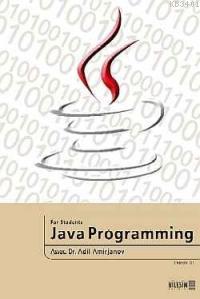9789752711778
90518

https://www.turkishbooks.com/books/java-programming-for-students-p90518.html
Java Programming For Students
6.40
This book was wrote by Ass. Prof. Adil Amirjanov studying in DAU-Lefkoşe. And it is designed as a second course in object-oriented programming using Java language. Main goal is to make students comfortable with the object-oriented approach so that they will be well-prepared to design and implement high-quality object-oriented software. This text was formed out of the author's experience with classroom teaching of Java.
When Java first emerged in mid-1995, most of the attention was focused on its applets and various Web effects. Over time, people have come to realize its larger benefits as a powerful object-oriented language that is well-designed and pedagogically sound.
This text is based on three ideas:
1. Object-oriented approach. In this text, every situation and example reinforces the design principles of object-oriented programming.
2. Integrated graphics. Modern software systems are graphical. Various examples in this text use graphics to motivate and engage students. GUI (Graphical User Interface) was introduced carefully, so students can appreciate the concepts of event-driven programming.
3. Balanced examples. The text contains a strong balance of smaller and larger examples. Smaller examples establish a foundation for students, whereas larger examples provide them with a more realistic context. I also balance the use of applications and applets throughout the text in order to give students a strong foundation in both approaches.
The text covers the Java language and is organized into 9 chapters. Chapter 1 provides the basic introduction to Java programming language. Chapter 2 starts getting down to details with the basic Java building blocks: data types, variables, and expressions such as arithmetic and comparisons. The chapter also discusses one of the most fundamental capabilities of object-oriented programming languages - inheritance. Chapter 4 introduces several Java components for creating programs with user-friendly graphical user interfaces (GUIs). Chapter 5 covers the exception handling in Java. Chapter 6 provides you with the standard way to archive your Java classes and other files into a single file. A Java archive or JAR file is a collection of Java classes and other files packed into a single file. Chapter 7 introduces Java's capabilities that enable programmers to implement applications that can perform tasks concurrently. Chapter 8 deals with input/output that is accomplished through streams of data directed to and from files. Chapter 9 discusses the Java Database Connectivity (JDBC) and the bridge JDBC-ODBC, which enables the applications to access data in database, Today's most popular database systems are relational databases and this particular type of databases is discussed in the chapter. The example in the chapter enables you to obtain data from the database with SQL (Structured Query Language) queries and display the data with GUI components.
You can use this book either as a cookbook or as a learning tool. If you have a specific problem that you need to solve, you can consult the book for the solution, as you might use a reference book.
This book was wrote by Ass. Prof. Adil Amirjanov studying in DAU-Lefkoşe. And it is designed as a second course in object-oriented programming using Java language. Main goal is to make students comfortable with the object-oriented approach so that they will be well-prepared to design and implement high-quality object-oriented software. This text was formed out of the author's experience with classroom teaching of Java.
When Java first emerged in mid-1995, most of the attention was focused on its applets and various Web effects. Over time, people have come to realize its larger benefits as a powerful object-oriented language that is well-designed and pedagogically sound.
This text is based on three ideas:
1. Object-oriented approach. In this text, every situation and example reinforces the design principles of object-oriented programming.
2. Integrated graphics. Modern software systems are graphical. Various examples in this text use graphics to motivate and engage students. GUI (Graphical User Interface) was introduced carefully, so students can appreciate the concepts of event-driven programming.
3. Balanced examples. The text contains a strong balance of smaller and larger examples. Smaller examples establish a foundation for students, whereas larger examples provide them with a more realistic context. I also balance the use of applications and applets throughout the text in order to give students a strong foundation in both approaches.
The text covers the Java language and is organized into 9 chapters. Chapter 1 provides the basic introduction to Java programming language. Chapter 2 starts getting down to details with the basic Java building blocks: data types, variables, and expressions such as arithmetic and comparisons. The chapter also discusses one of the most fundamental capabilities of object-oriented programming languages - inheritance. Chapter 4 introduces several Java components for creating programs with user-friendly graphical user interfaces (GUIs). Chapter 5 covers the exception handling in Java. Chapter 6 provides you with the standard way to archive your Java classes and other files into a single file. A Java archive or JAR file is a collection of Java classes and other files packed into a single file. Chapter 7 introduces Java's capabilities that enable programmers to implement applications that can perform tasks concurrently. Chapter 8 deals with input/output that is accomplished through streams of data directed to and from files. Chapter 9 discusses the Java Database Connectivity (JDBC) and the bridge JDBC-ODBC, which enables the applications to access data in database, Today's most popular database systems are relational databases and this particular type of databases is discussed in the chapter. The example in the chapter enables you to obtain data from the database with SQL (Structured Query Language) queries and display the data with GUI components.
You can use this book either as a cookbook or as a learning tool. If you have a specific problem that you need to solve, you can consult the book for the solution, as you might use a reference book.
Yorumlar (0)
Yorum yaz
Bu kitabı henüz kimse eleştirmemiş.










